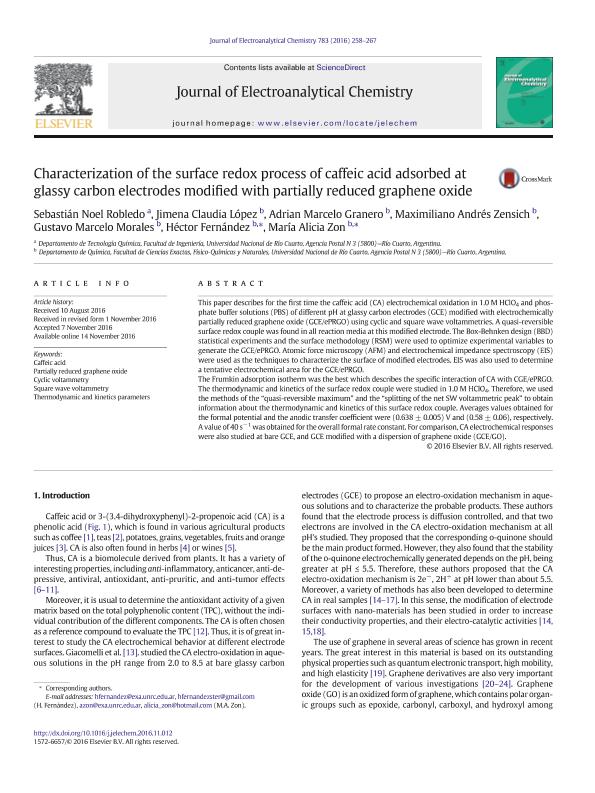Mostrar el registro sencillo del ítem
dc.contributor.author
Robledo, Sebastian Noel

dc.contributor.author
López, Jimena Claudia

dc.contributor.author
Granero, Adrian Marcelo

dc.contributor.author
Zensich, Maximiliano Andres

dc.contributor.author
Morales, Gustavo Marcelo

dc.contributor.author
Fernandez, Hector

dc.contributor.author
Zon, María Alicia

dc.date.available
2019-03-21T19:01:17Z
dc.date.issued
2016-12
dc.identifier.citation
Robledo, Sebastian Noel; López, Jimena Claudia; Granero, Adrian Marcelo; Zensich, Maximiliano Andres; Morales, Gustavo Marcelo; et al.; Characterization of the surface redox process of caffeic acid adsorbed at glassy carbon electrodes modified with partially reduced graphene oxide; Elsevier; Journal of Electroanalytical Chemistry; 783; 12-2016; 258-267
dc.identifier.issn
0022-0728
dc.identifier.uri
http://hdl.handle.net/11336/72221
dc.description.abstract
This paper describes for the first time the caffeic acid (CA) electrochemical oxidation in 1.0 M HClO4 and phosphate buffer solutions (PBS) of different pH at glassy carbon electrodes (GCE) modified with electrochemically partially reduced graphene oxide (GCE/ePRGO) using cyclic and square wave voltammetries. A quasi-reversible surface redox couple was found in all reaction media at this modified electrode. The Box-Behnken design (BBD) statistical experiments and the surface methodology (RSM) were used to optimize experimental variables to generate the GCE/ePRGO. Atomic force microscopy (AFM) and electrochemical impedance spectroscopy (EIS) were used as the techniques to characterize the surface of modified electrodes. EIS was also used to determine a tentative electrochemical area for the GCE/ePRGO. The Frumkin adsorption isotherm was the best which describes the specific interaction of CA with CGE/ePRGO. The thermodynamic and kinetics of the surface redox couple were studied in 1.0 M HClO4. Therefore, we used the methods of the “quasi-reversible maximum” and the “splitting of the net SW voltammetric peak” to obtain information about the thermodynamic and kinetics of this surface redox couple. Averages values obtained for the formal potential and the anodic transfer coefficient were (0.638 ± 0.005) V and (0.58 ± 0.06), respectively. A value of 40 s− 1 was obtained for the overall formal rate constant. For comparison, CA electrochemical responses were also studied at bare GCE, and GCE modified with a dispersion of graphene oxide (GCE/GO).
dc.format
application/pdf
dc.language.iso
eng
dc.publisher
Elsevier

dc.rights
info:eu-repo/semantics/openAccess
dc.rights.uri
https://creativecommons.org/licenses/by-nc-nd/2.5/ar/
dc.subject
Caffeic Acid
dc.subject
Cyclic Voltammetry
dc.subject
Partially Reduced Graphene Oxide
dc.subject
Square Wave Voltammetry
dc.subject
Thermodynamic And Kinetics Parameters
dc.subject.classification
Otras Ciencias Químicas

dc.subject.classification
Ciencias Químicas

dc.subject.classification
CIENCIAS NATURALES Y EXACTAS

dc.title
Characterization of the surface redox process of caffeic acid adsorbed at glassy carbon electrodes modified with partially reduced graphene oxide
dc.type
info:eu-repo/semantics/article
dc.type
info:ar-repo/semantics/artículo
dc.type
info:eu-repo/semantics/publishedVersion
dc.date.updated
2019-03-21T14:19:53Z
dc.journal.volume
783
dc.journal.pagination
258-267
dc.journal.pais
Países Bajos

dc.journal.ciudad
Amsterdam
dc.description.fil
Fil: Robledo, Sebastian Noel. Universidad Nacional de Rio Cuarto. Facultad de Ingeniería. Departamento de Tecnología Química; Argentina. Consejo Nacional de Investigaciones Científicas y Técnicas; Argentina
dc.description.fil
Fil: López, Jimena Claudia. Universidad Nacional de Río Cuarto. Facultad de Ciencias Exactas Fisicoquímicas y Naturales. Departamento de Química; Argentina. Consejo Nacional de Investigaciones Científicas y Técnicas; Argentina
dc.description.fil
Fil: Granero, Adrian Marcelo. Universidad Nacional de Río Cuarto. Facultad de Ciencias Exactas Fisicoquímicas y Naturales. Departamento de Química; Argentina. Consejo Nacional de Investigaciones Científicas y Técnicas; Argentina
dc.description.fil
Fil: Zensich, Maximiliano Andres. Universidad Nacional de Río Cuarto. Facultad de Ciencias Exactas Fisicoquímicas y Naturales. Departamento de Química; Argentina. Consejo Nacional de Investigaciones Científicas y Técnicas; Argentina
dc.description.fil
Fil: Morales, Gustavo Marcelo. Universidad Nacional de Río Cuarto. Facultad de Ciencias Exactas Fisicoquímicas y Naturales. Departamento de Química; Argentina. Consejo Nacional de Investigaciones Científicas y Técnicas; Argentina
dc.description.fil
Fil: Fernandez, Hector. Universidad Nacional de Río Cuarto. Facultad de Ciencias Exactas Fisicoquímicas y Naturales. Departamento de Química; Argentina. Consejo Nacional de Investigaciones Científicas y Técnicas; Argentina
dc.description.fil
Fil: Zon, María Alicia. Universidad Nacional de Río Cuarto. Facultad de Ciencias Exactas Fisicoquímicas y Naturales. Departamento de Química; Argentina. Consejo Nacional de Investigaciones Científicas y Técnicas; Argentina
dc.journal.title
Journal of Electroanalytical Chemistry

dc.relation.alternativeid
info:eu-repo/semantics/altIdentifier/url/http://www.sciencedirect.com/science/article/pii/S1572665716306154
dc.relation.alternativeid
info:eu-repo/semantics/altIdentifier/doi/http://dx.doi.org/10.1016/j.jelechem.2016.11.012
Archivos asociados
